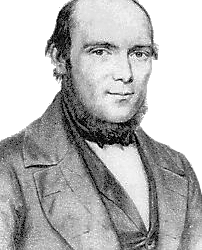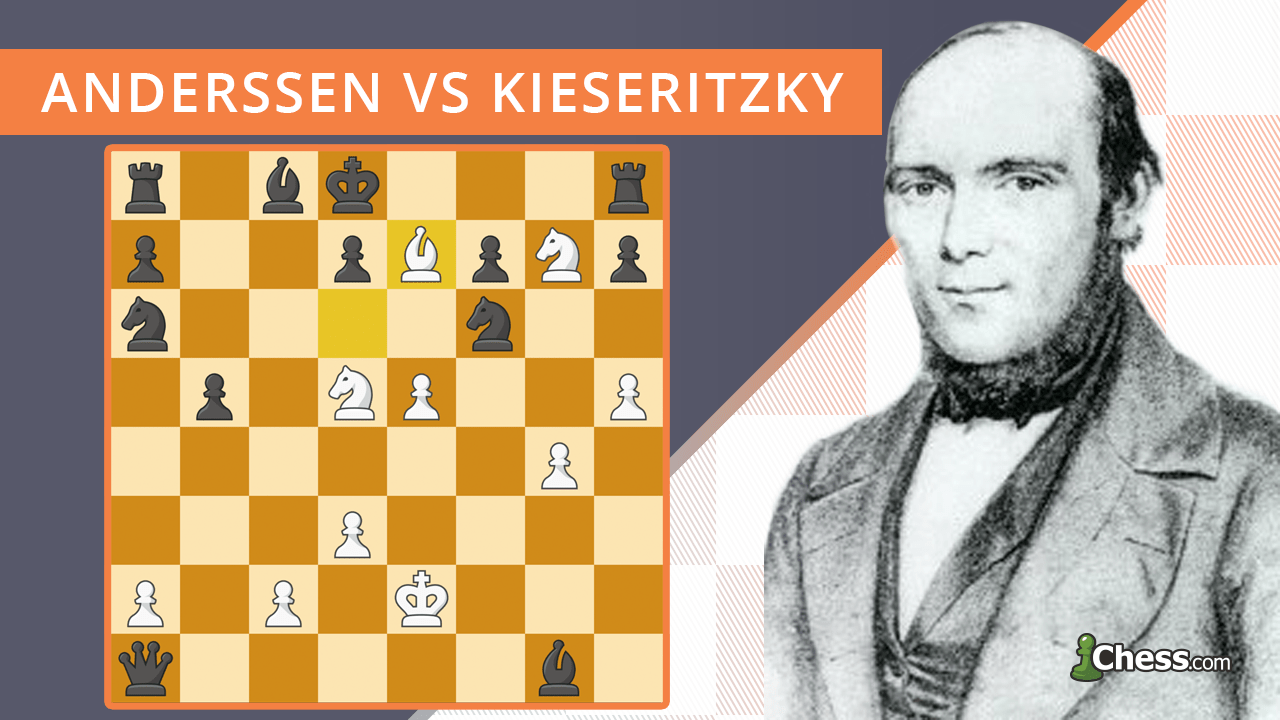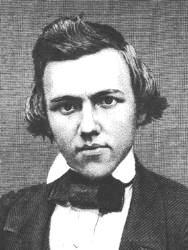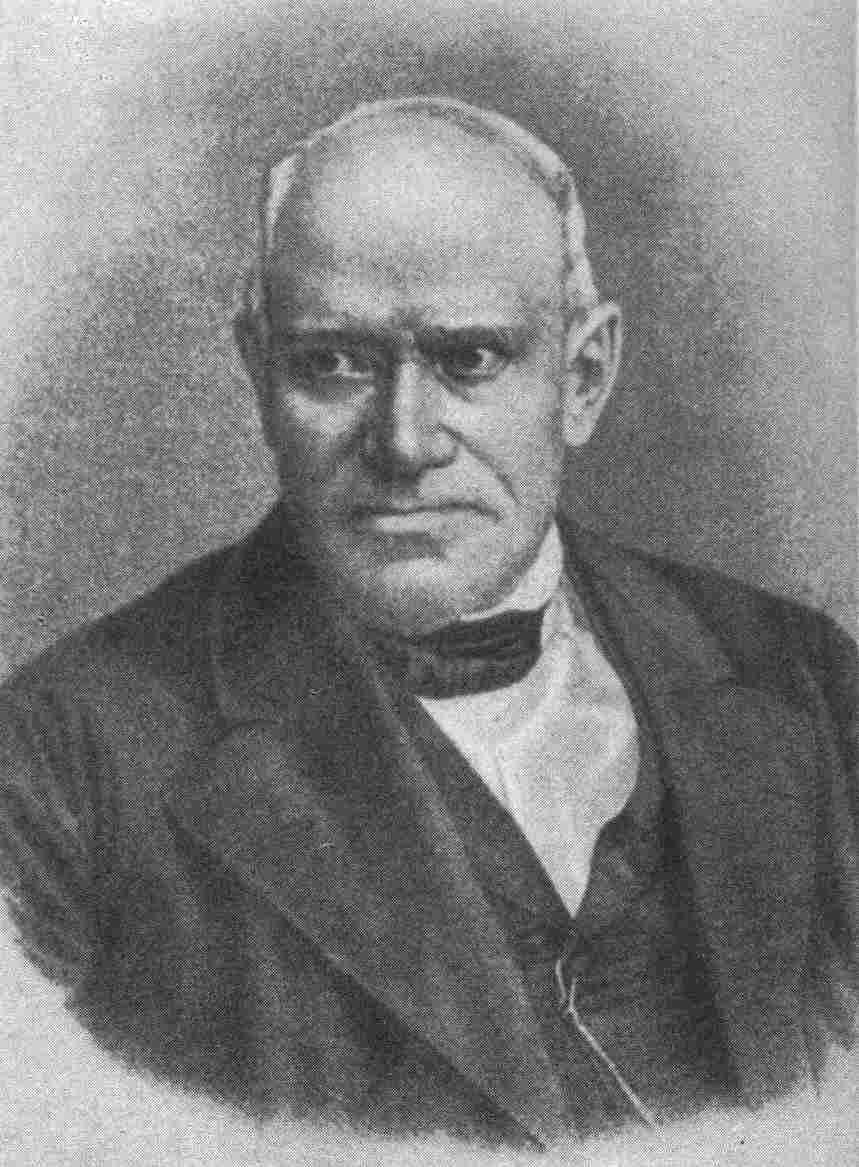Adolf Anderssen

Bio
Adolf Anderssen was a German master and the leading player in the world from 1851 to 1858 and again from 1860 to 1866 (both before and after Paul Morphy). He is best known for his tactical genius as well as his "Immortal Game" and "Evergreen Game" masterpieces.
Anderssen is also known for his matches with Morphy and Wilhelm Steinitz and for winning the first international chess tournament (London 1851). He was the teacher of Johannes Zukertort (a world-class player of the 19th century) and is also considered a pioneer for chess-problem compositions.
- Style
- Early Days To Chess-Problem Composer
- World's Leading Player
- Morphy-Anderssen Match
- 1862 London International Tournament
- Steinitz-Anderssen Match
- Late Career
- Legacy
Style
Anderssen had a romantic attacking style. He used gambits and offbeat openings (including his own Anderssen's Opening with 1.a3?!), but regardless of the opening his play was full of brilliant tactical blows and sacrifices. Anderssen's abilities to create combinations and develop rapidly are notable.

These traits are on display in the "Immortal Game" below. Anderssen sacrifices a bishop, then both rooks and ultimately his queen to create this historic checkmate—a memorable and classic attack.
Early Days To Chess-Problem Composer
Anderssen learned how to play chess at the age of nine from his father, but it would not become a large part of his life until much later. Instead of pursuing chess alone Anderssen studied philosophy and mathematics at school and eventually became a mathematics professor. He began composing chess problems while attending a university, and in 1842 he published a collection of 60 compositions.
Anderssen's chess compositions got the attention of the Berlin chess scene, and he started playing in matches. In 1848 he drew a match with the chess professional Daniel Harrwitz. Because of his performance in this match and his growing reputation, Anderssen was asked to represent Germany in 1851 in the first international chess tournament to be held in London.
World's Leading Player
The tournament in London was historical for many reasons, mainly because it was the first international tournament but also because it collected many of the world's strongest players. To the surprise of many, Anderssen won the tournament ahead of the world's best (including the tournament organizer and British champion Howard Staunton).
The London Chess Club organized a tournament, which Anderssen won convincingly, a month after the international tournament. At this point he was viewed not only as a world-class player but as the leading player in the world.

Between 1851 and 1858, tournaments were still very rare, but in 1852 Anderssen's famous "Evergreen Game" was played. This masterpiece starts with the Evan's Gambit and develops regularly until Anderssen sacrifices a knight on move 17, his other knight on move 19 and then his rook on move 20. These sacrifices set the stage for the memorable queen sacrifice on move 21 that forces mate! A game for the ages:
Morphy-Anderssen Match
In late 1858 Anderssen faced the chess legend Paul Morphy, who had already defeated many masters on his European tour that year, but many were anticipating the Morphy-Anderssen match. Anderssen was considered the leading player in the world before Morphy stepped on the stage and began defeating everyone he played.
The match was quite lopsided, as Morphy proved his superiority over Anderssen and won the match with a devastating 8-3 score (seven wins, two losses, two draws). Anderssen used his unusual opening 1.a3?! in several games against Morphy. In the tenth game of the match, Anderssen defeated Morphy with his offbeat opening.
Unlike most of Anderssen's wins, this game was very positional in nature and resembles a modern-day English Opening. The game begins with a somewhat closed structure and then slowly transitions to an endgame where Anderssen uses his bishop pair masterfully to bring home the full point.
After winning this match against Anderssen and then defeating more masters, Morphy returned to the United States in 1859 and was regarded as the strongest player in the world. However, he promptly retired from chess the very same year, and everyone wondered who the next best player would be.

In 1860 Ignac Kolisch (a world-class player of the time) challenged Anderssen to a match, which was drawn. They played a rematch in 1861 that Anderssen won. This result suggested that Anderssen was the leading active player in the world.
1862 International London Tournament
In 1862 another international tournament was held in London. The event was historical as it was the first tournament to have a time control as well as the first international tournament to use the round-robin system. The tournament had 14 master participants, including Louis Paulsen, Joseph Blackburne, Johann Loewenthal and future world champion Steinitz.
Anderssen was the favorite to win, and he didn't disappoint—he won the tournament with a convincing 12/13 score. This cemented Anderssen as the leading player in the world (again).

In this game from 1862 Anderssen does what he did best: he conducted an amazing attack, sacrificed his queen and delivered checkmate. Anderssen's opponent may have thought that he couldn't attack as well on the queenside or with the black pieces, but he was wrong! Another classic attacking miniature.
Steinitz-Anderssen Match
In 1866 Anderssen faced Steinitz. The winner of the match would be the first to eight wins. The match, which was violent with the King's Gambit and Evan's Gambit being displayed in almost every game, had a decisive result in every game—not a single draw!
Anderssen drew first blood by winning game one. Steinitz was forced to resign after Anderssen's 36.Qe8+!, winning the black queen.
After game one, Steinitz won four games in a row and had a commanding 4-1 lead. Anderssen replied by winning the next four games to take a 5-4 lead! In game seven Anderssen won an exchange after Steinitz declined the bishop sacrifice on move 16. Steinitz resigned shortly after the beautiful stroke 30.Nxh7!
After losing games six through nine, Steinitz again answered with back-to-back wins that brought the match score to 6-5 in his favor. Anderssen won game 12 to level the score at 6-6, but Steinitz would finish the match with another set of back-to-back wins.
Steinitz won this historic roller-coaster match by the score of 8-6 and was now viewed as the leading player in the world. He wouldn't lose a match for the next 30 years, when he lost the 1894 world championship match to Emanuel Lasker.
Late Career
After losing the 1858 match to Morphy and the 1866 match to Steinitz, Anderssen rededicated himself to chess. His results during 1866-1878 in the late stages of his career are remarkable, as he won five of the nine major tournaments he played in. In the four tournaments he didn't win, he finished second twice and third twice.

Anderssen won the historic 1870 Baden-Baden tournament ahead of Steinitz, Blackburne, Paulsen and five other masters. In this brilliant game from this time, Anderssen defeats his former pupil, Johannes Zukertort. The queen sacrifice forcing mate on move 29 is worth remembering.
Legacy
Anderssen passed away in 1879 at the age of 60. He will always be remembered as the winner of the first international chess tournament (London 1851) and for his brilliant combinations and attacking style. Anderssen's queen sacrifices are still the topic of books, articles and videos today.
With the exception of Morphy, no other player could equal Anderssen's tactical abilities in the mid-1800s. According to Steinitz, "We all may learn from Morphy and Anderssen how to conduct a kingside attack, and perhaps I myself may not have learned enough." Although his career may have been somewhat overshadowed by Morphy and Steinitz, his accomplishments and contributions to the game should never be forgotten.


